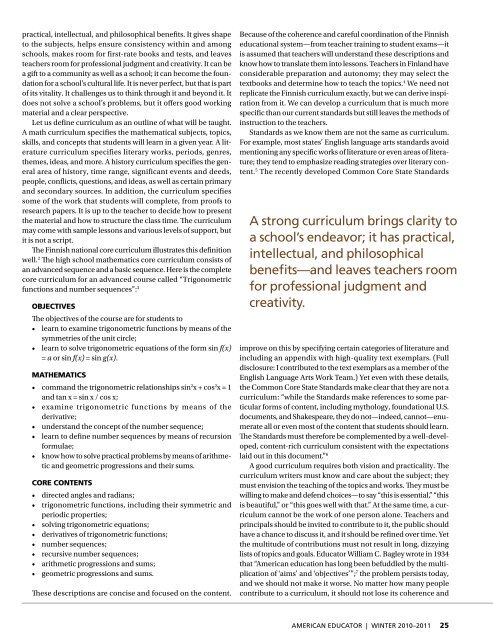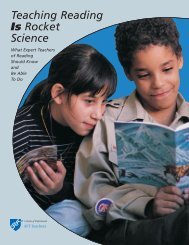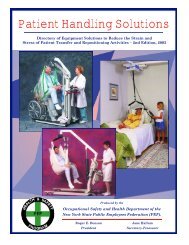American Educator, Winter 2010-11, Vol. 34, No. 4, AFT
American Educator, Winter 2010-11, Vol. 34, No. 4, AFT
American Educator, Winter 2010-11, Vol. 34, No. 4, AFT
You also want an ePaper? Increase the reach of your titles
YUMPU automatically turns print PDFs into web optimized ePapers that Google loves.
practical, intellectual, and philosophical benefits. It gives shape<br />
to the subjects, helps ensure consistency within and among<br />
schools, makes room for first-rate books and tests, and leaves<br />
teachers room for professional judgment and creativity. It can be<br />
a gift to a community as well as a school; it can become the foundation<br />
for a school’s cultural life. It is never perfect, but that is part<br />
of its vitality. It challenges us to think through it and beyond it. It<br />
does not solve a school’s problems, but it offers good working<br />
material and a clear perspective.<br />
Let us define curriculum as an outline of what will be taught.<br />
A math curriculum specifies the mathematical subjects, topics,<br />
skills, and concepts that students will learn in a given year. A literature<br />
curriculum specifies literary works, periods, genres,<br />
themes, ideas, and more. A history curriculum specifies the general<br />
area of history, time range, significant events and deeds,<br />
people, conflicts, questions, and ideas, as well as certain primary<br />
and secondary sources. In addition, the curriculum specifies<br />
some of the work that students will complete, from proofs to<br />
research papers. It is up to the teacher to decide how to present<br />
the material and how to structure the class time. The curriculum<br />
may come with sample lessons and various levels of support, but<br />
it is not a script.<br />
The Finnish national core curriculum illustrates this definition<br />
well. 2 The high school mathematics core curriculum consists of<br />
an advanced sequence and a basic sequence. Here is the complete<br />
core curriculum for an advanced course called “Trigonometric<br />
functions and number sequences”: 3<br />
OBJECTIVES<br />
The objectives of the course are for students to<br />
• learn to examine trigonometric functions by means of the<br />
symmetries of the unit circle;<br />
• learn to solve trigonometric equations of the form sin f(x)<br />
= a or sin f(x) = sin g(x).<br />
MATHEMATICS<br />
• command the trigonometric relationships sin2x + cos2x = 1<br />
and tan x = sin x / cos x;<br />
• examine trigonometric functions by means of the<br />
derivative;<br />
• understand the concept of the number sequence;<br />
• learn to define number sequences by means of recursion<br />
formulae;<br />
• know how to solve practical problems by means of arithmetic<br />
and geometric progressions and their sums.<br />
CORE CONTENTS<br />
• directed angles and radians;<br />
• trigonometric functions, including their symmetric and<br />
periodic properties;<br />
• solving trigonometric equations;<br />
• derivatives of trigonometric functions;<br />
• number sequences;<br />
• recursive number sequences;<br />
• arithmetic progressions and sums;<br />
• geometric progressions and sums.<br />
These descriptions are concise and focused on the content.<br />
Because of the coherence and careful coordination of the Finnish<br />
educational system—from teacher training to student exams—it<br />
is assumed that teachers will understand these descriptions and<br />
know how to translate them into lessons. Teachers in Finland have<br />
considerable preparation and autonomy; they may select the<br />
textbooks and determine how to teach the topics. 4 We need not<br />
replicate the Finnish curriculum exactly, but we can derive inspiration<br />
from it. We can develop a curriculum that is much more<br />
specific than our current standards but still leaves the methods of<br />
instruction to the teachers.<br />
Standards as we know them are not the same as curriculum.<br />
For example, most states’ English language arts standards avoid<br />
mentioning any specific works of literature or even areas of literature;<br />
they tend to emphasize reading strategies over literary content.<br />
5 The recently developed Common Core State Standards<br />
A strong curriculum brings clarity to<br />
a school’s endeavor; it has practical,<br />
intellectual, and philosophical<br />
benefits—and leaves teachers room<br />
for professional judgment and<br />
creativity.<br />
improve on this by specifying certain categories of literature and<br />
including an appendix with high-quality text exemplars. (Full<br />
disclosure: I contributed to the text exemplars as a member of the<br />
English Language Arts Work Team.) Yet even with these details,<br />
the Common Core State Standards make clear that they are not a<br />
curriculum: “while the Standards make references to some particular<br />
forms of content, including mythology, foundational U.S.<br />
documents, and Shakespeare, they do not—indeed, cannot—enumerate<br />
all or even most of the content that students should learn.<br />
The Standards must therefore be complemented by a well-developed,<br />
content-rich curriculum consistent with the expectations<br />
laid out in this document.” 6<br />
A good curriculum requires both vision and practicality. The<br />
curriculum writers must know and care about the subject; they<br />
must envision the teaching of the topics and works. They must be<br />
willing to make and defend choices—to say “this is essential,” “this<br />
is beautiful,” or “this goes well with that.” At the same time, a curriculum<br />
cannot be the work of one person alone. Teachers and<br />
principals should be invited to contribute to it, the public should<br />
have a chance to discuss it, and it should be refined over time. Yet<br />
the multitude of contributions must not result in long, dizzying<br />
lists of topics and goals. <strong>Educator</strong> William C. Bagley wrote in 19<strong>34</strong><br />
that “<strong>American</strong> education has long been befuddled by the multiplication<br />
of ‘aims’ and ‘objectives’ ”; 7 the problem persists today,<br />
and we should not make it worse. <strong>No</strong> matter how many people<br />
contribute to a curriculum, it should not lose its coherence and<br />
AMERICAN EDUCATOR | WINTER <strong>2010</strong>–20<strong>11</strong> 25





